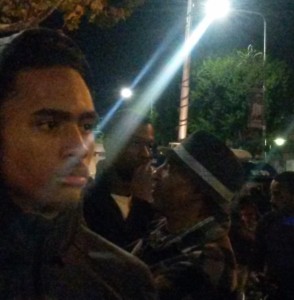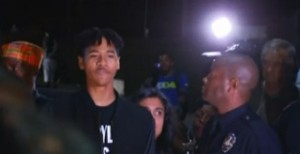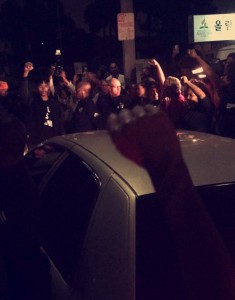 “What do we want? JUSTICE. When do we want it? NOW.”
“What do we want? JUSTICE. When do we want it? NOW.”
I chanted along as I watched my son engaged in social protest. My palms began to sweat and my jaw tense as I watch him. I wondered if my son was at the line of civil disobedience or had he already crossed it. He is an absolutely beautiful young man, tall with broad shoulders and a smile that melts my heart. I am his mother and I love him dearly.
I know he has the right to protest what he sees as injustice. I have taught him, and countless college students that it is our duty to participate in the struggle to create a just society. From schoolyards, where they might encounter someone bullying someone else, to encountering homeless people on the streets of Los Angeles, I have taught my children that to ignore injustice is to further inflict it. However, in this moment, I am his mother. In this moment, as police surround him as he angrily argues his rights, I am afraid for my beautiful son, my man-child. I am acutely aware that Michael Brown, Tamir Rice, and Sandra Bland have mothers that thought them beautiful and whom now, mourn them. In this moment, my pride that my in my 17-year-old son has learned, and is extending my life lessons regarding social activism are mixed inextricably with a mother’s fear.
In 1955, a fourteen-year-old boy was brutally murdered in Mississippi. Emmett Till, like many young African American boys today, lived with his mother in a single-parent household. Mamie Till, anguished at the loss of her only child, nevertheless decided upon an open casket to make sure the world knew what happened to her son. Many scholars, myself included, believe the choice to make public and lay bare the horrors of the murder was pivotal in launching the beginning of The Civil Rights Movement.
 On April 27th 2015, a video of rioting in Baltimore was broadcast on the news and shared widely on social media. In the video, a woman wades through the crowd and hits and yells at her rioting son. An angry crowd of rioters had exploded in response to the gruesome death Freddie Gray, a young black man who died while in police custody. Media stories and interviews with ‘Baltimore Mom’ generally deemed her actions as necessary to keep the city, and her son, safe. See was celebrated by many as “Mom of the Year”.
On April 27th 2015, a video of rioting in Baltimore was broadcast on the news and shared widely on social media. In the video, a woman wades through the crowd and hits and yells at her rioting son. An angry crowd of rioters had exploded in response to the gruesome death Freddie Gray, a young black man who died while in police custody. Media stories and interviews with ‘Baltimore Mom’ generally deemed her actions as necessary to keep the city, and her son, safe. See was celebrated by many as “Mom of the Year”.
My response, the actions of Mamie Till and “Baltimore Mom” represent the weight of black motherhood. In the United States, around 67 percent of black families with children live in households with an unmarried mother. In fact, then, as now, women like Baltimore mom, Mamie Till, and myself, are portrayed as emblematic of “THE REAL” problem besetting black communities. Like Mamie Till, I am divorced from my son’s father. Although the fact that his father and I continue to co-parent our children despite the change in our marital status, and the fact that I am a professor with an advanced degree, should both be logically considered mitigating factors, our family is nonetheless included in statistics described by The Moynihan Report as representing “a tangle of pathology.” The Moynihan report, written 50 years ago to buttress Lyndon B. Johnson’s “War on Poverty”, is among the most famous pieces of social scientific analysis. In my twenty years of research of African American families, I have yet to see policy or research on black family that fails to reference it. While the report cogently assessed the constraining impact of discrimination on intimate relationships options available to Black men and women, it also imposed a biased and limiting meaning regarding marriage fragility. The Moynihan Report, and contemporary popular opinion both generally place single-black motherhood at the top of the list of self-inflicted harms, right alongside discussions of “black-on-black crime.” The Moynihan Report explicitly asserted that Black women’s strength emasculated Black men and thereby caused criminality and a host of other pathologies. Today the harms of black, single mother families are unarticulated but nevertheless presumed. Post-Civil Rights Movement changes in welfare policy, along with ‘War on Drugs’, are key components in the emergence of what law professor and author Michelle Alexander calls The New Jim Crow. In Baltimore, in Ferguson, in Los Angeles, as well as in urban Black communities everywhere, the impact of the “New Jim Crow” has been deeply felt. High numbers of community residents are incarcerated in prisons all over the country and are therefore absent from their families. “Baltimore Mom’s” response seemed to me to be emblematic of the toxic circumstances brought on by the criminalization of entire communities.
In 2015, as was the case in 1965 and 1955 before that, single motherhood continues to be associated with poverty and inequality, as well as with cultural arguments about the social problems observed in urban black communities. Simply put, race continues to influence how most people in society think about the links between marriage, childbearing, and the host of structural problems confronting African American communities. Oddly, even as American families have become far more diverse, and increasingly we interrogate the collateral costs of the “War on Drugs”, critical interrogations of the logic of “family dysfunction” as the cause of black people’s problems, is rare. In fact, even President Barack Obama, the first black president of the United States, and himself a product of a single mother, began several initiatives to build “strong communities” by promoting “responsible fatherhood” as a primary strategy.
Americans of every race continue to decry the “deterioration” of urban black communities as being directly linked to family behavior, and lament the tragic impact of the loss of “traditional family values”. This is indeed the context for “Baltimore Mom’s” initial elevation.
I did not succumb to fear as I watched my son impolitely assert that “Black Lives Matter” in an uncivil protest in front of the church that night. Instead, I saw myself joined with my son and countless other mothers, fathers, step-fathers, siblings, cousins and play-cousins, across time and geography to stand together and unapologetically demand meaningful political response to police abuses. Because, Black Lives Matter, really.
Professor James is co-author, along with Donna L. Franklin, of the newly revised paperback edition of Ensuring Inequality: Structural Transformations of the African American Family, Oxford University Press. 2015. She has devoted her academic life to understanding racial inequality, and her personal life to eradicating it.

Comments 2
Perry T. — November 25, 2015
Beautiful!
Perry T. — November 25, 2015
Beautiful post.